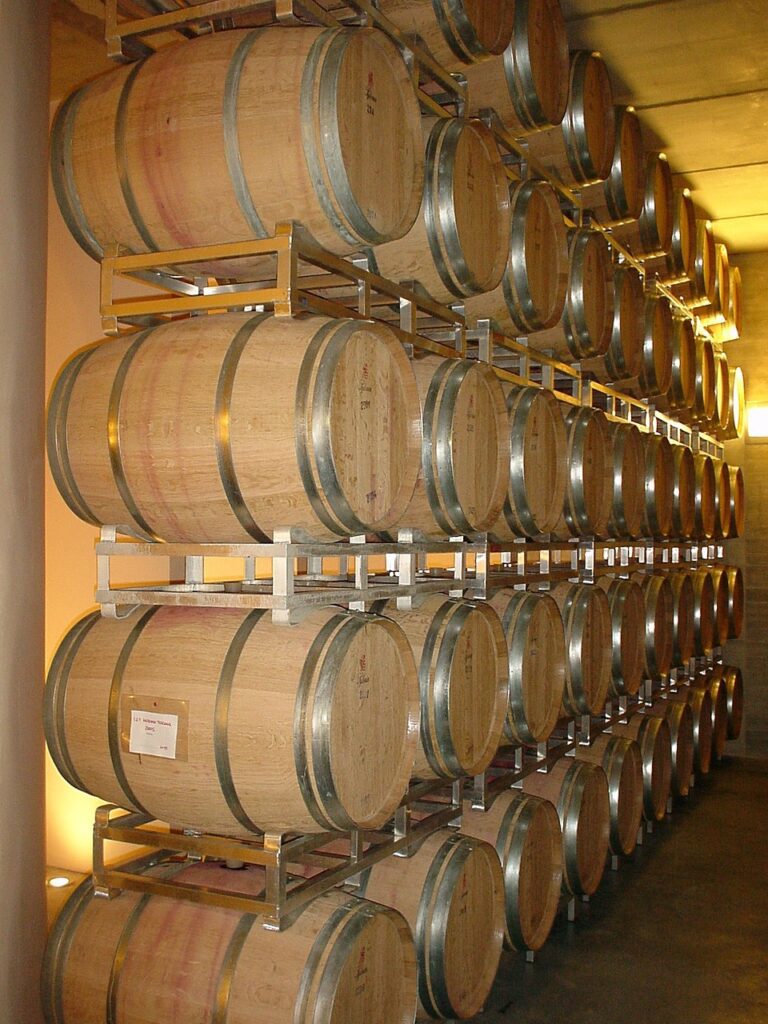The cleaning and sequential sanitation of cellars and equipment are essential to maintain the required cellar hygiene. Cellar hygiene is indispensable to ensure that the spoilage of wine is prevented.
Ozone (O3) has already long been used as sanitiser in wine cellars. It destroys all bacteria, viruses, yeasts, moulds, enzymes, biofilms, microbial membranes and spores. Micro-organisms can also not develop resistance towards it. It has a half-life of several hours in dry air, but in water it varies from immediate to several hours depending on different factors like pH, temperature and pressure. The ozone molecule consists of three oxygen (O) atoms. It is formed by the ultraviolet irradiation of sunlight and the oxygen in the atmosphere. Its concentration on the global surface is 0,01 to 0,05 ppm, but as a result of air pollution it can be increased. It smells like a diluted chlorine solution. In cellars it is mainly used for the sanitation of tanks, barrels, equipment and surfaces. A 2,5 ppm ozonated water solution is for example used for two minutes for the sanitation of barrels, after the barrels have been cleaned with warm water. For seriously contaminated barrels, a five-minute contact period is however required. Ozone also limits the build-up of organic material in barrels, which can increase the lifespan of barrels. It can also be used effectively for the sanitation of floors to limit the cross contamination of containers. Ozone is also the preferred sanitiser to replace chlorine-based sanitation.
As a result of its price, it can also be used as a rinsing agent and many cellars use it for all tanks, before they are filled. Cleaning in Place (CIP) is another process where ozone can be used beneficially. When chlorine or iodine are used together with high pressure warm water as a sanitiser for hoses, pipelines and other systems, it must be rinsed several times with water to remove the sanitiser. The use of halogens can also promote the formation of mould compounds like TCA and TBA. The use of ozone as an alternative can save labour, energy costs and water consumption in such cases. In comparison with warm water or steam, the energy cost and water consumption are also considerably less. This will consequently also benefit the waste water management of cellars.
Chemical alternative sanitation requires up to 10 litres of water for each litre of wine produced. This has a negative environmental impact. One of the main advantages of ozone is its reactivity in an aqueous solution. This implies that matter is oxidised 10 to 1 000 times quicker than other oxidants. Due to the short half-life of ozone it cannot be stocked, but must be generated at the cellar. Most ozone generation equipment is operated at a water pressure of 69 to 1 034 kpa and an ozone concentration of 3 to 11 ppm is produced. It can be mobile or stationary equipment. High concentrations of ozone are toxic, but aqueous solutions thereof are safe. Workers should be capable of smelling ozone in a work environment. If they are exposed to such an atmosphere longer than 15 minutes, they must move to a safer atmosphere. Safety standards regarding the potential exposure of cellar assistants to ozone are prescribed. After the use of an aqueous ozone solution, it decomposes into oxygen. The pH of ozone is neutral and does not, like alkaline caustic or potash soda or acid solutions have an influence on the pH of rinsing water.
Although ozone does not corrode stainless steel or damage most plastic products, it is not a solution for all problems. It destroys for example natural rubber products like gaskets, pump seals, rubber hoses and glass-fibre containers. It is a sanitiser and not a cleaning agent and can consequently not remove cream of tartar, deposits or corrosion like other cleaning agents. The efficiency of sanitisers is expressed as a log function. A 1-log sanitiser kills 10% of all microbes, a 4-log agent kills 99,99% of all microbes. Canadian research confirmed that ozone is a 4-log agent regarding the killing of Brettanomyces bruxellensis.
Reference
Le Lacheur, P., 2021. The pros and cons of using ozone to sterilise wineries. Australian and New Zealand Grapegrower and Winemaker (685), February 2021: 48 – 50.













